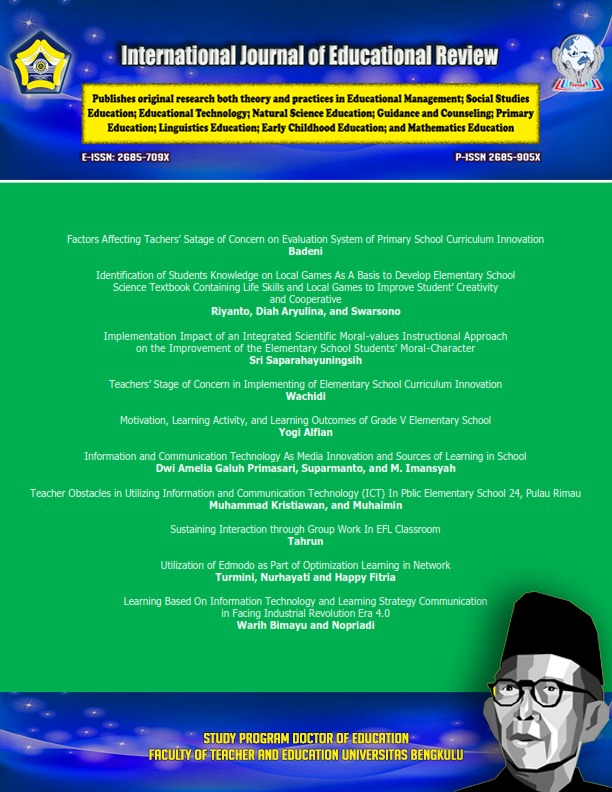Impact of an Integrated Scientific Moral Values Instructional Approach on the Improvement of the Elementary School Students’ Moral Character
DOI:
https://doi.org/10.33369/ijer.v1i2.8842Keywords:
Effectivity, Implementation, Moral-Character, Integrated Scientific Instructional ModelAbstract
The purpose of this research is to know the impact of the implementation of an integrated moral-values instructional approach on the development of the elementary school students' moral character. The research was conducted in the form of a test-retest experiment. The results of this research showed that the implementation of the integrated scientific moral-values instructional approach on an instructional process of social studies is able to increase 67% of the improvement the moral- characters compared to the implementation scientific approach contained in the content of social studies to the student intact. The instructional approach is very effective to develop students’ moral-characters.References
Abdul Aziz Wahab dan Sapriya (2011). Teori dan Landasan Pendidikan Kewarganegaraan. Bandung: Alfabeta, 2011
Abdul Majid dan Dian Andayani (2011). Pendidikan Karakter Perspektif Islam. Bandung: PT Remaja Rosda-Karya, 2012
Arthur, J., 2005. The Re-emergence of Character Education in British Education Policy. British Jurnal of Educational Studies, 53, 239-254
Menteri Pendidikan dan Kebudayaan (2014). Buku Guru Ilmu Pengetahuan Sosial Kelas VIIIl. Jakarta: Kementerian Pendidikan dan Kebudayaan.
Dharma Kesuma dkk. (2011) Pendidikan Karakter Kajian Teori dan Praktik di Sekolah. Bandung: PT Remaja Rosdakarya.
Dolph, Katie, and Lycan, Angela (2008). Moral Reasoning: A necessary Standard of Learning in Todays Classroom. Journal of Cross-Disciplinary Perspectives in Education, Vol. 1, No 1, May.
Huitt, W. Values (2004). Educational Psychology Interactive. Valdosta, GA: Valdosta State University. Retrieved [date], from http://www. Edpsycinter-active.org/topics/ affect/ values.html
Kristiawan, M. (2015). A Model of Educational Character in High School Al-Istiqamah Simpang Empat, West Pasaman, West Sumatera. Research Journal of Education, 1(2), 15-20.
Kristiawan, M., & Tobari. (2017). The Characteristics of the Full Day School Based Elementary School. Transylvanian Review, 1(1).
Koran Sindo, 28 January 2014).
Lipe, David(2010). A Critical Analysis of Values Clarification. Montgomery (USA): Apologetic Press, Inc.
Miller, Mary (2012). Teaching and Learning in Affective Domain-Emerging Perspective http://projects. coe.edu/epltt/ index.php?title= Teaching
Mohammad Arwani, 2008. Memaknai Tradisi Berkat Muludan di Kranjin Purworejo dalam Irwan Abdullah, Ibnu Mujib, M. Iqbal Ahnaf (Ed,). Agama dan Kearifan Lokal dalam Tantangan Global. Yogyakarta: Sekolah pascasarjana UGM, pp.187-2011.
Sarlito Wirawan Sartono (2010). Pengantar Psikologi Umum, Jakarta: Rajawali Pers.
Sayer, I. M., Kristiawan, M., & Agustina, M. (2018). Fairy Tale as a Medium for Children’s Character Cooperation Building. Al-Ta lim Journal, 25(2), 108-116.
Sugiyono (2008). Metode Penelitian Pendidikan: Pendekatan Kuantitatif, Kualitatif, dan R & D. Bandung: Alfabeta.
White, Robert, Michael (2008). Building Schools of Character: The Development, Implementation, and Evaluation of a School-Based Character Education Programme Designed to Promote Cooperative Learning and Reduce Anti-Social Behaviour, Durham theses, Durham University. Available at Durham E-Theses Online: http://etheses.dur.ac.uk/189/
Downloads
Published
How to Cite
Issue
Section
License

This work is licensed under a Creative Commons Attribution-ShareAlike 4.0 International License.




